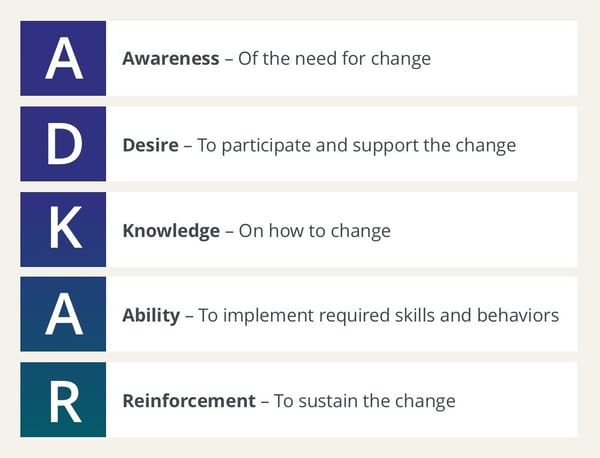Overcome Resistance to ERP Systems Changes With ADKAR

6 Mins
Updated: August 29, 2025
Published: April 29, 2024

Investing in Enterprise Resource Planning (ERP) software can unify your business information resources, improve productivity, and create other long-term benefits. However, adoption challenges and resistance often create unforeseen risks and detract from the ERP system's benefits. Here’s how the Prosci ADKAR® Model can help you succeed.
ERP Systems and the Need for Change
To gain efficiency and reduce long-term costs, large and small companies are transitioning to ERP systems. Businesses use the systems to manage and improve processes ranging from procurement and manufacturing to financial and human resources functions across the enterprise. All these efforts help eliminate waste, improve productivity, and increase employee satisfaction.
Because an ERP system integrates data into a common database, data can flow easily between operations. As a result, the system eliminates data duplication, enhances data integrity, improves ease-of-use, and helps your teams overcome siloed operations. Integrated data and processes also give your managers and teams greater insight into decision-making from real-time information.
Given your significant investment in time and resources, as well as the importance of the expected benefits from the project, it’s critical for your business to recognize and overcome resistance to ERP changes through effective change management.
Resistance to ERP Systems and Other Adoption Challenges
More than likely, your employees have grown accustomed to familiar legacy systems. Even with all the benefits offered through an ERP tool, the migration from familiar applications to a new system sets up a series of challenges for technical and people leaders. As impacted employees move from the comfort of the current state to the disruption of the transition state and ultimately to the future state, technical challenges often provoke people challenges that lead to resistance.
As part of your planning for the ERP implementation, leaders and the project team should carefully establish the business requirements and expected benefits for the project. Without clearly established requirements and benefits, people who work with the system can create unrealistic expectations. In turn, unrealistic expectations often evolve into customization requests that increase the project scope and slow the schedule.
During implementation, impacted people can struggle with completing their current work while learning a new system. Project teams need to focus on all the milestones for reaching the “go live” date while implementing technological, functional and process changes at a rapid pace. And the push to learn new skills, terms and processes elevates stress levels even further.
Cascading Technical and People Challenges
.webp?width=700&height=494&name=Cascading%20Technical%20and%20People%20Challenges-01%20(7).webp)
Each of these challenges increases project risk. The need for understanding and mitigating that risk underscores the need for building strong change management capabilities in your organization. If you don’t adequately manage those challenges, the technical and people challenges of an ERP implementation can lead to dissatisfied employees and other stakeholders, increased stress, and loss of trust.
Fear and Resistance to Change During an ERP Implementation
The changes caused by an ERP implementation often seem intensely personal and overwhelming to employees. Newly defined processes sometimes move tasks from one department to another or even lead to organizational restructuring. Some department workloads may increase while others decrease or shift to different areas. Each of those changes break apart comfortable working relationships. And all this occurs within a project schedule that seems to have a life and vocabulary of its own. The result is often fear and resistance.
Fear of Change
Certainly, the fear of change feeds resistance behaviors. With any shift to a different technology, fear of the unknown shapes how your staff responds to change. Migration to an ERP system amplifies this fear because no one sees the finished product until close to the project go-live date. Even though vendors and project leads work to assure teams that more efficient workflows and a more collaborative environment are coming—and ask for patience as the process unfolds—people who use the new system may not fully accept the assurances.
Fear of the Unknown
Implementing an ERP system creates the need for people to learn new skills, creating pressure to upskill and reskill within a limited time. People also need to stay productive with their current workloads while learning new skills, which stresses even the most experienced people. For mid-career employees in particular, the fear of learning new skills can increase stress, complicate decision-making, and even cause physical illness.
Fear of Failure
The fear of failure translates into reluctance to try new processes or practices. If people work around or otherwise avoid the root causes of their fear (i.e., the learning curve), the fear leads to other resistance behaviors.

How the ADKAR Model Helps You Overcome Resistance to ERP Systems
Effective change management is critical during ERP implementations because of the impact on everyday work and morale. From my vantage point, the Prosci ADKAR Model offers optimal alignment with an ERP implementation and helps individual people and similarly impacted groups move through the transition in a structured way.
Because the ADKAR Model emphasizes the people side of change, people managers also become more aware of the complexity in the work people do, as well as the impact software development and testing has on it.
Along with its focus on the people side of change, the ADKAR Model emphasizes project success. Change management through the ADKAR Model helps business leaders mitigate resistance, highlights the ability of employees to adopt the change, and then checks back to reinforce those abilities.
The Prosci ADKAR Model

Here’s how each ADKAR element applies when mitigating or overcoming resistance to ERP systems:
Awareness
Building Awareness helps mitigate resistance by answering the questions people have about the change and its impacts on their work.
Implementing any change that cuts across organizational and cultural lines requires excellent communication from leaders, people managers and project leads. As you apply the ADKAR Model, you will also need to build Awareness of the need for implementing an ERP system and communicate information about the project itself. I have found that communication must flow vertically and horizontally with clear lanes for sharing and receiving information.
Desire
Building Desire addresses resistance by answering the questions people have during a change, including the business “Why” behind the change and personal “What’s in it for me?”
The Desire to participate and support the change begins with business leaders delivering transparent communications about the reasons for the change and then advocating for the new vision. Successful ERP implementations depend on change practitioners gathering feedback from impacted groups, people managers quickly responding and addressing barriers, and sponsors encouraging people to participate and role modeling the right behaviors. Productive communication and active participation build alignment with the objectives of the ERP strategy.
Knowledge
Knowledge of how to adopt the ERP system lessens fears and doubts, and helps people prepare for their role as users in adopting the change.
When considering Knowledge, change practitioners should advocate for ERP training programs that address both the technical aspects of the new system as well as any process and workflow changes people need to adopt and use. While your human resources department may need training about new recruiting and onboarding procedures, finance teams will need training that addresses accounts receivable and payable processes, invoicing, purchase requisitions, and end-of-fiscal year procedures. Along with specific training for staff in impacted departments, project leads must also consider how those and other procedures affect people and stakeholders, and the type of training that best serves their needs.
Ability
Giving people the opportunity to apply and demonstrate new skills acquired through training helps them prepare for the go-live date while building confidence in their Ability to implement the required skills and behaviors.
Change practitioners can help your organization achieve its goals by ensuring that employees have the ability to adopt and apply the changes enabled by the ERP implementation. To build Ability, change practitioners should work with people managers to provide hands-on practice and coaching. As employees across the enterprise become proficient with the new ERP tools, they can help others learn new skills.
Reinforcement
Resistance occurs at all stages of change, and it’s common for people to develop workarounds or revert to old ways of working. Reinforcement enables you to help people stay the course through additional support and resistance management tactics.
When reinforcing the ERP system change with the ADKAR Model, change practitioners should work with the project team to gather feedback from impacted groups about how they use ERP tools. Using insights from surveys and face-to-face meetings, the project team can make changes that help people do their work most effectively. When measuring performance, change practitioners often use scorecards that show progress towards implementing changes and realizing benefits.
Preparing to Overcome Resistance to ERP Changes
When implementing an ERP system, change practitioners need to start managing resistance at the project’s initiation and all throughout its lifecycle. The process of managing resistance begins with assessing the organizational readiness of your business for the change, usually in partnership with the project manager and vendor representatives.
The process continues with identifying primary and secondary stakeholders, assessing impacts and risks, and engaging stakeholders before the ERP implementation. I ask that change practitioners also begin to address the ADKAR barrier points for staff impacted by the change before the implementation begins.
When assessing the possible resistance to change, I encourage change practitioners to apply the Prosci 10 aspects of change impact. It’s a helpful tool for defining the change for individuals, addressing individual and group impacts, and as the basis for building adoption metrics. In addition, the aspects establish a framework for becoming more responsive to employee needs and improving engagement.
Prosci 10 Aspects of Change Impact

Reframing and Overcoming Resistance to ERP Changes
Effectively understanding and managing resistance requires you to look at it through a different lens that removes negativity and blame. Reframing resistance in this way will help you better identify types of resistance and their root causes, and build the right tactics to help people move through their barriers.
Your organization can realize even greater benefits from an ERP implementation by applying a robust change management methodology that incorporates the ADKAR Model. This ensures alignment between the organizational requirements for the ERP system and the needs of the people who are impacted by the change while ensuring a solid return on your ERP project investment.




